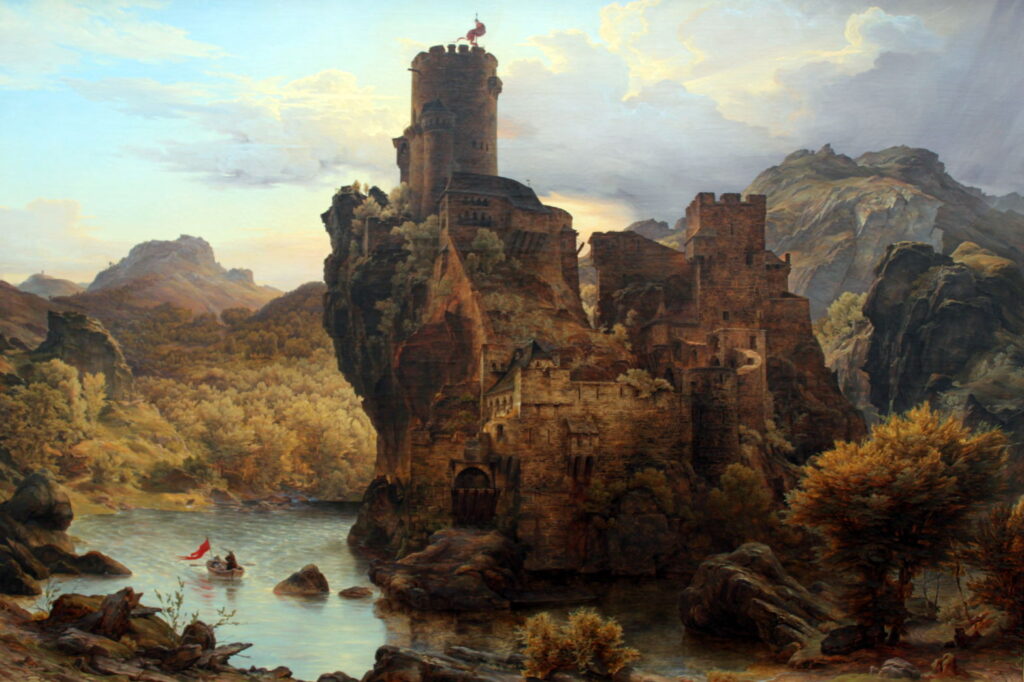Sea of Mists: Other common themes

So far in this series, I have shown collections of the paintings by the German Romantic artists with their common themes of the Rückenfigur, nocturnes, sailing ships, and barren trees. Before moving on to look at the paintings of some of their pupils, this article is a brief summary of some of their other common themes.
Mist and mountains
Caspar David Friedrich (1774–1840), Wanderer above the Sea of Mists (1818), oil on canvas, 94.8 × 74.8 cm, Kunsthalle Hamburg. Wikimedia Commons.
Caspar David Friedrich’s famous Wanderer above the Sea of Mists from 1818, whose title I’ve used as that of this series, uses extensive mist and cloud both to detach its scenery from ground level, and to maintain its pervasive air of mystery. With its Rückenfigur, we look out over a blanket of lower cloud, pierced by occasional rock pinnacles and peaks. In the distance, more gradual slopes suggest higher mountains to the sides, and vaguer forms of rounded peaks, and a massive rocky butte, fading into mist.
Johan Christian Dahl (1788–1857), The Watzmann (1825), oil on canvas, 33 x 45 cm, Nasjonalmuseet for kunst, arkitektur og design, Oslo, Norway. Wikimedia Commons.
Eight years later, in 1826, JC Dahl painted one of Friedrich’s favourite mountains, The Watzmann, here without the aid of mist or cloud to render a sense of isolation or desolation. This is the third highest peak in Germany, south of the village of Berchtesgaden in the Bavarian Alps.
Castles and ruins
These are characteristic of the ‘Gothic’, and favourite locations for all the German Romantics.
Carl Gustav Carus (1789–1869), Ruins of the Eldena Monastery with a Cottage near Greifswald in Moonlight (1819-20), oil on canvas, 43 x 33 cm, Pommersches Landesmuseum, Greifswald, Germany. Wikimedia Commons.
Carl Gustav Carus painted these Ruins of the Eldena Monastery with a Cottage near Greifswald in Moonlight in 1819-20, showing another of Friedrich’s favourite motifs. These imposing remains of the former Cistercian monastery near Greifswald in Pomerania, to the south of Germany’s Baltic coast, were also painted by Friedrich from about 1809 onwards, for example in The Abbey in the Oakwood.
Carl Gustav Carus (1789–1869), Rudelsburg Castle (1825), oil on canvas, 52 x 67 cm, Kunsthalle Bremen, Bremen, Germany. Image by jean louis mazieres, via Wikimedia Commons.
Rudelsburg Castle, which Carus painted in 1825, is another Romantic/Gothic location on the River Saale, in Saxony, central Germany. In the nineteenth century, its ruins became a popular focal point for walkers, and grapevines were planted in its grounds.
Carl Friedrich Lessing (1808–1880), Knight’s Castle (1828), oil on canvas, 138 x 194 cm, Alte Nationalgalerie, Berlin, Germany. Image by anagoria, via Wikimedia Commons.
Carl Friedrich Lessing’s early paintings often feature castles with vertiginous walls set in rugged terrain, of which his Knight’s Castle from 1828 is a good example.
Carl Friedrich Lessing (1808–1880), Rocky Landscape, Gorge with Ruin (date not known), media and dimensions not known, Städelsches Kunstinstitut und Städtische Galerie, Frankfurt, Germany. Image © José Luiz Bernardes Ribeiro, via Wikimedia Commons.
Lessing’s undated view of a Rocky Landscape, Gorge with Ruin, shows the ultimate Gothic horror of the burned-out ruins of an old castle beside an icefall, in higher ground towards the Alps.
Dresden skyline
German Romantic painters were centred on the city of Dresden, and painted some of the finest views of its skyline before it was destroyed by Allied bombing in early 1945.
Carl Gustav Carus (1789–1869), View of Dresden at Sunset (c 1822), oil on canvas, 22 x 30.5 cm, Kunstsammlungen Chemnitz, Chemnitz, Germany. Wikimedia Commons.
View of Dresden at Sunset from about 1822 is one of Carus’ finest paintings, with the famous spires and towers of the city of Dresden seen against the rich, warm light of dusk.
Carl Gustav Carus (1789–1869), View of Dresden from Brühl’s Terrace (1830-31), oil on canvas, 28.5 x 21.7 cm, Museum Georg Schäfer, Schweinfurt, Germany. Wikimedia Commons.
View of Dresden from Brühl’s Terrace is another late twilight view, painted by Carus in 1830-31. This shows an elevated embankment above the River Elbe in Dresden, a popular terrace for walking. It’s named after the Count who had a city palace and gardens built there in the eighteenth century. The nearby church is the Cathedral of the Holy Trinity, which only gained the status of cathedral in 1964.
Johan Christian Dahl (1788–1857), Dresden at Night (1845), oil on cardboard, 7 × 11.3 cm, Private collection. Wikimedia Commons.
JC Dahl’s tiny plein air sketch of Dresden at Night, painted in 1845, is a tribute to his skill at painting in front of the motif at night.




